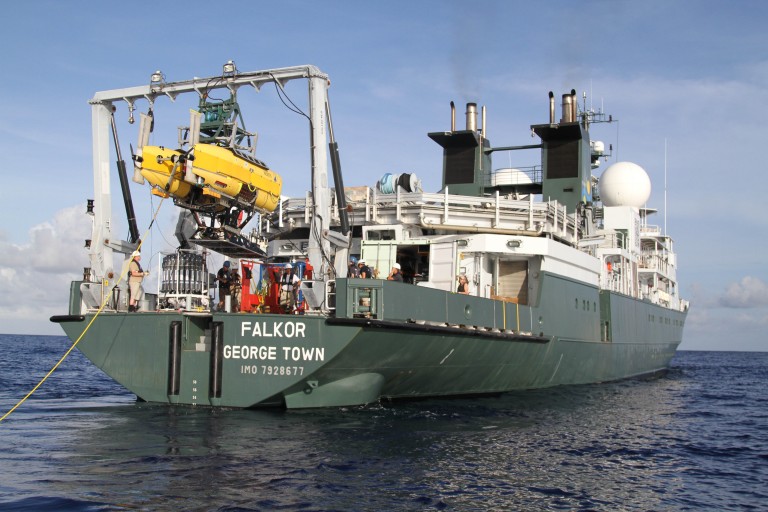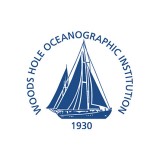Throughout the month of June 2013, a team of oceanographers and astrobiologists continued their systematic exploration of one of the deepest points in the Caribbean Sea, searching for life in extreme seafloor environments. Using the hybrid underwater robotic vehicle Nereus, these scientists extended their investigations throughout the depths of the Mid-Cayman Rise, which reaches to more than 6,500 meters (~4 miles) deep.
The study area, also known as the Mid-Cayman Spreading Center, is one of Earth’s deepest and slowest-spreading mid-ocean ridges—regions where two of Earth’s tectonic plates are ripped apart and new material wells up from the Earth’s interior. There, our scientists searched for and sampled new hydrothermal vent systems—natural, seafloor plumbing systems where cold seawater circulates down into the hot, freshly-formed oceanic crust releasing heat and mineral-rich fluids at the seafloor that support complex ecosystems of exotic organisms.
By exploring this extreme and previously uninvestigated section of the Earth’s deep seafloor, this research seeks to extend our understanding of the limits (in terms of extreme environments) to which life can exist on Earth, to understand how geologic processes might generate the prebiotic materials believed to have been an essential pre-cursor to life on Earth, and to help prepare for future efforts to explore for life on other planets.
R/V Falkor supported a broad variety of scientific operations during the two legs of this cruise, including CTD casts, multibeam mapping, operation of an add-on HROV Nereus in both AUV (during Leg 1) and ROV modes (during Leg 2) for high resolution vent site mapping, chemical and physical data collection at vent sites, interactive research at vent sites, observation and sampling of associated biological communities, and satellite teleoperations with shore-side scientists. Leg 1 left port in St. Petersburg, FL May 30 and concluded in George Town, Grand Cayman on June 16, 2013. After a personnel change and transition of Nereus into ROV-mode, Leg 2 left George Town June 19 and return to port June 30, 2013. During Leg 2, video from Nereus dives was viewable online during scheduled live events. The live event schedule was posted and updated here.
Data & Publications
The resulting shipboard dataset is being stored at the Rolling Deck to Repository and is now available.
Metagenomic reads of the subseafloor microbes at Mid-Cayman Rise are archived with the European Nucleotide Archive.
- German, C.R., et al. (2014). Cruise Report: Hydrothermal Exploration of the Mid-Cayman Rise FK-008 (OASES 2013), 51pp + 6 Appendices.
- Appendix One: Hydrothermal Exploration of the Mid-Cayman Rise Event Logger Report FK008
- Appendix Two: Hydrothermal Exploration of the Mid-Cayman Rise CTD Casts FK008
- Appendix Three: Hydrothermal Exploration of the Mid-Cayman Rise AUV Nereus Operations Report FK008
- Appendix Four: Hydrothermal Exploration of the Mid-Cayman Rise ROV Nereus Dive Plans FK008
- Estapa, M.L., J.A. Breier & C.R. German (2015). Particle dynamics in the rising plume at Piccard Hydrothermal Field, Mid-Cayman Rise. Geochemistry, Geophysics, Geosystems, 16, 2762 - 2774. DOI: 10.1002/2015GC005831.
- German, C.R. (2014). Hydrothermal exploration in distant oceans: Oases for life on Earth and Beyond.” Invited paper at Biosignatures Meeting (Nordic Institute for Astrobiology), Bergen, Norway. May 2014.
- Huber, J.A. (2014). Subseafloor microbial life in venting fluids from the Mid Cayman Rise hydrothermal system. Deep Carbon Observatory Deep Life Meeting. Portland, OR.
- McDermott, J.M. (2014). Geochemistry of Deep-Sea Hydrothermal Vent Fluids from the Mid-Cayman Rise, Caribbean Sea. WHOI-MIT Joint Program.
- McDermott, J.M., J.S Seewald, C.R. German & S.P. Sylva. (2014). Constraints on hydrocarbon and organic acid abundances in hydrothermal fluids at the Von Damm vent field, Mid-Cayman Rise. American Geophysical Union Fall Meeting, San Francisco, CA, USA.
- Versteegh, E.A.A., C.L.Van Dover & M.Coleman (2014). Unsuspected dietary habits of hydrothermal vent shrimp: bacterivorous Rimicaris hybisae can be carnivorous or even cannibalistic. EGU General Assembly: Geophysical Research Abstracts 16, EGU2014-2408.
- Looking for Life in Oceans on Earth & in Space. Guest Speaker Series, Aquarium of the Pacific October 2nd, 2014. Podcast video available.
- Anderson, R., Reveillaud, J., Eren, A.M., McDermott, J., Seewald, J., Stepanauskas, R., and J.A. Huber. (2016). Strain-level variation of subseafloor microbial populations from venting fluids at the Mid-Cayman Rise. Oral Presentation, International Society for Microbial Ecology General Meeting, Montreal, CAN.
- Huber, J.A. (2015). Microbial Life Beneath the Seafloor. Oral Presentation, American Society for Microbiology General Meeting, New Orleans, LA, USA.
- Huber, J.A. (2015). How Geochemical Landscapes Shape Subseafloor Microbial Communities at Deep-sea Hydrothermal Vents. Oral Presentation, Gordon Research Conference on Chemical Oceanography, Holdren, NH, USA.
- Anderson, R., Reveillaud, J., Reddington, E., Delmont, T., Eren, A., McDermott, J., Seewald, J., and Huber, J. (2017). Genomic Variation in Microbial Populations Inhabiting the Marine Subseafloor at Deep-sea Hydrothermal Vents. Nature Communications 8, 1114 (2017), doi: 10.1038/s41467-017-01228-6. [This article is published as OPEN ACCESS].
- McDermott, J., Sylva, S., Ono, S., German, C., and Seewald, J. (2018). Geochemistry of Fluids from Earth's Deepest Ridge-crest Hot-springs: Piccard Hydrothermal Vent Field, Mid-Cayman Rise. Geochimica et Cosmochimica Acta, 228, 95-118, doi: 10.1016/j.gca.2018.02.021.
- Galambos, D., Anderson, R., Reveillaud, J., and Huber, J. (2019). Genome-resolved metagenomics and metatranscriptomics reveal niche differentiation in functionally redundant microbial communities at deep-sea hydrothermal vents. Env. Microbiology, doi: 10.1111/1462-2920.14806. [This article has been published as OPEN ACCESS].
- McDermott, J., Sylva, S., Ono, S., German, C. and Seewald, J. (2020). Abiotic redox reactions in hydrothermal mixing zones: Decreased energy availability for the subsurface biosphere. PNAS, 117(34) 20453-20461, doi: 10.1073/pnas.2003108117. [This article is published as OPEN ACCESS].
- Moulana, A., Anderson, R., Fortunato, C., and Huber, J. (2020). Selection is a Significant Driver of a Gene Gain and Loss in the Pangenome of the Bacterial Genus Sulfurovum in Geographically Distinct Deep-sea Hydrothermal Vents. mSystems, 5(2) e00673-19; doi: 10.1128/mSystems.00673-19. [This article is published as OPEN ACCESS].
- Thomas, E., Anderson, R., Li, V., Rogan, J., and Huber, J. (2020). Diverse viruses have restricted biogeography in deep-sea hydrothermal vent fluids. bioRxiv, doi: 10.1101/2020.06.04.125666. [This article is published has OPEN ACCESS, is a pre-print, and has not been certified by peer review].
- Reveillaud, J., Reddington, E., McDermott, J., Algar, C., Meyer, J., Sylva, S., et. al. (2016). Subseafloor microbial communities in hydrogen-rich vent fluids from hydrothermal systems along the Mid-Cayman Rise. Env. Microbiology, 18(6), doi: 10.1111/1462-2920.13173. [This article is published as OPEN ACCESS].
- Hoffert, M., Anderson, R., Reveillaud, J., Murphy, L, Stepanauskas, R., and Huber, J. (2021). Genomic Variation Influences Methanothermococcus Fitness in Marine Hydrothermal Vents. Front. Microbiol. 12:71490, doi: 10.3389/fmicb.2021.714920. [This article was published as OPEN ACCESS with SOI's support].
- Thomas, E., Anderson, R., Li, V., Rogan, L., and Huber, J. (2021). Diverse Viruses in Deep-sea Hydrothermal Vent Fluids Have Restricted Dispersal across Ocean Basins. Geomicrobiology 6(3), doi: 10.1128/mSystems.00068-21. [This article is published as OPEN ACCESS].
In the News
Extreme Shrimp May Hold Clues to Alien Life
Jet Propulsion Laboratory • November 21st, 2014
Northern prawn: Aliens from Jupiter Moon
Spiegel Online • November 25th, 2014


